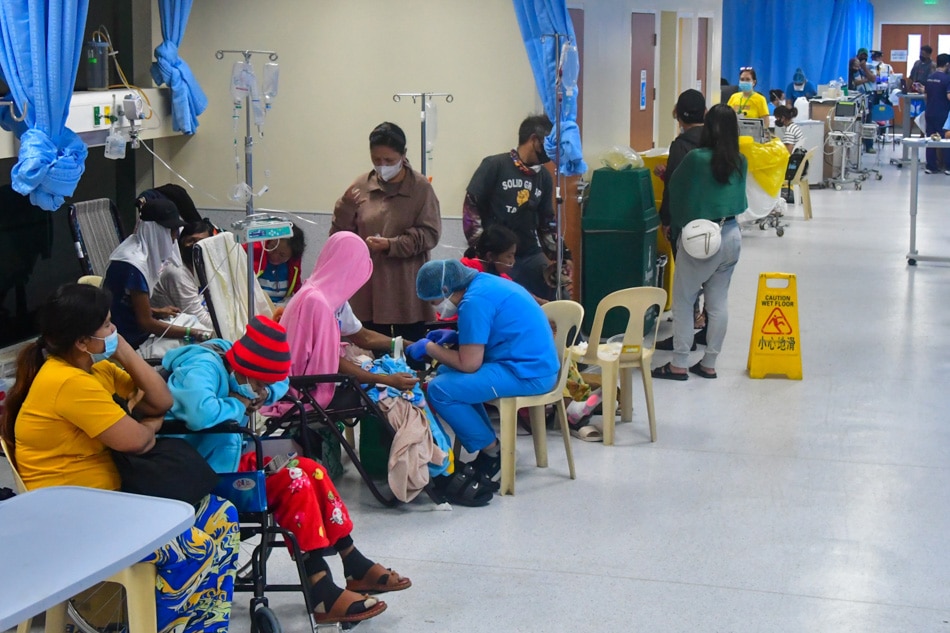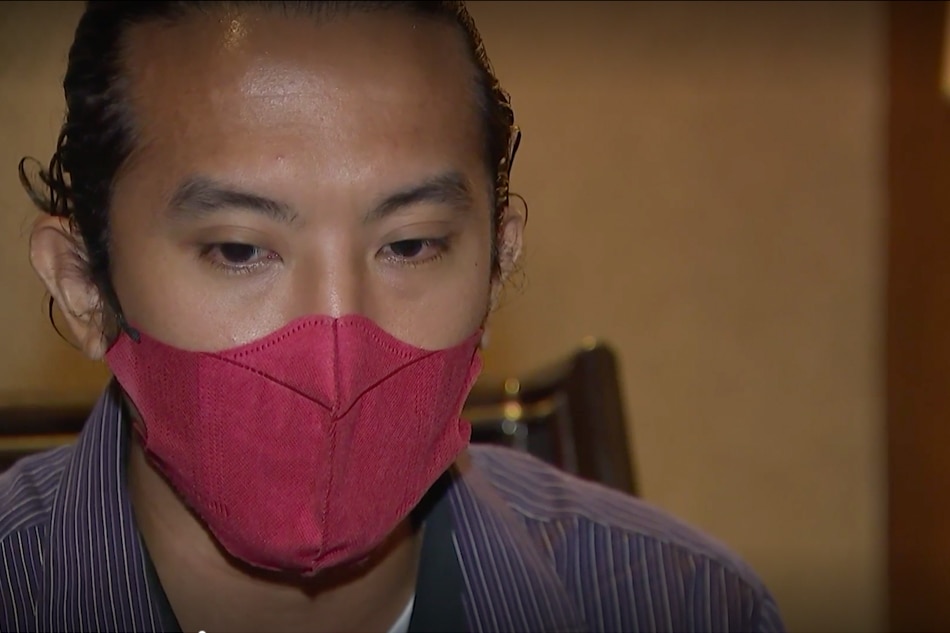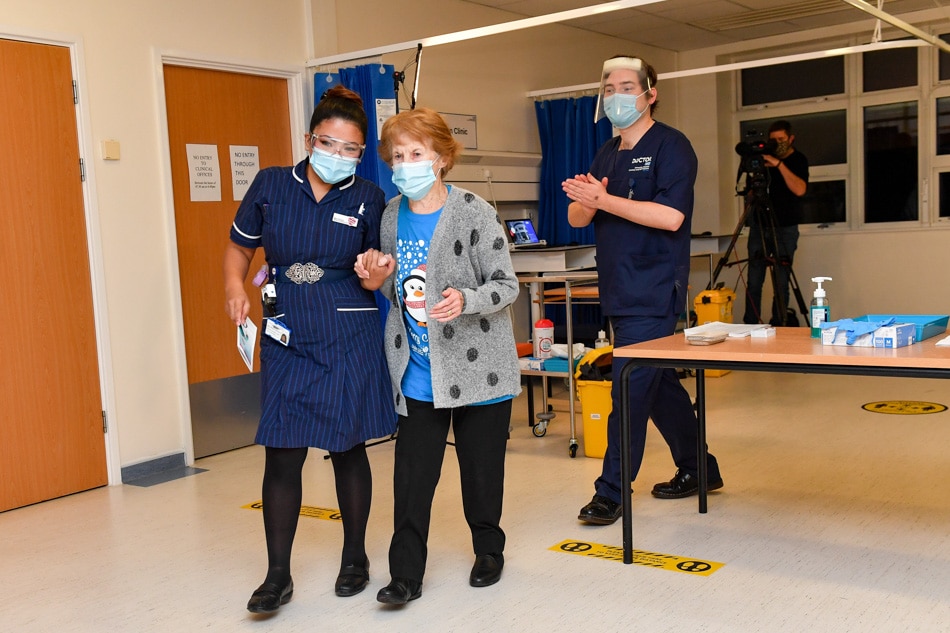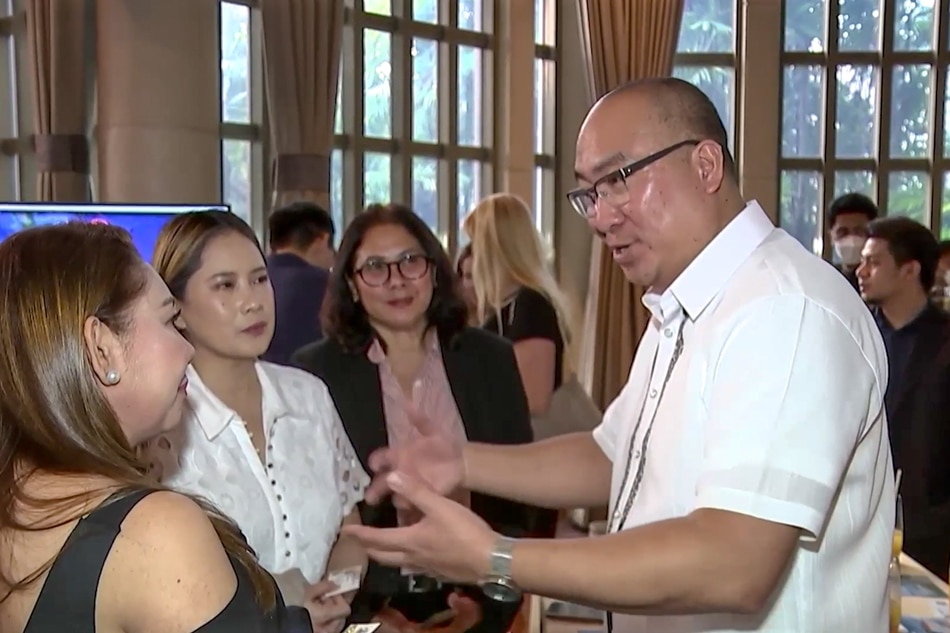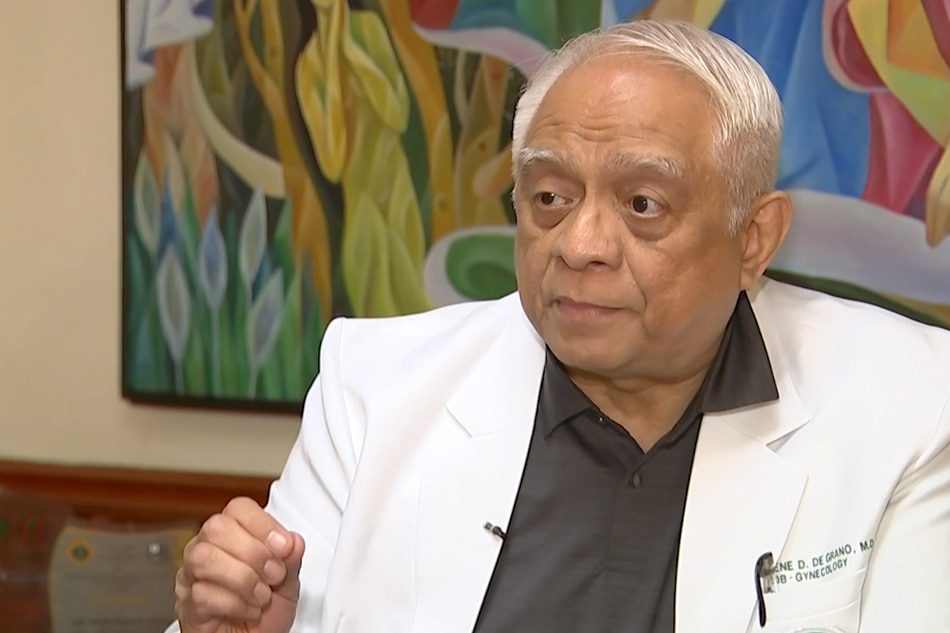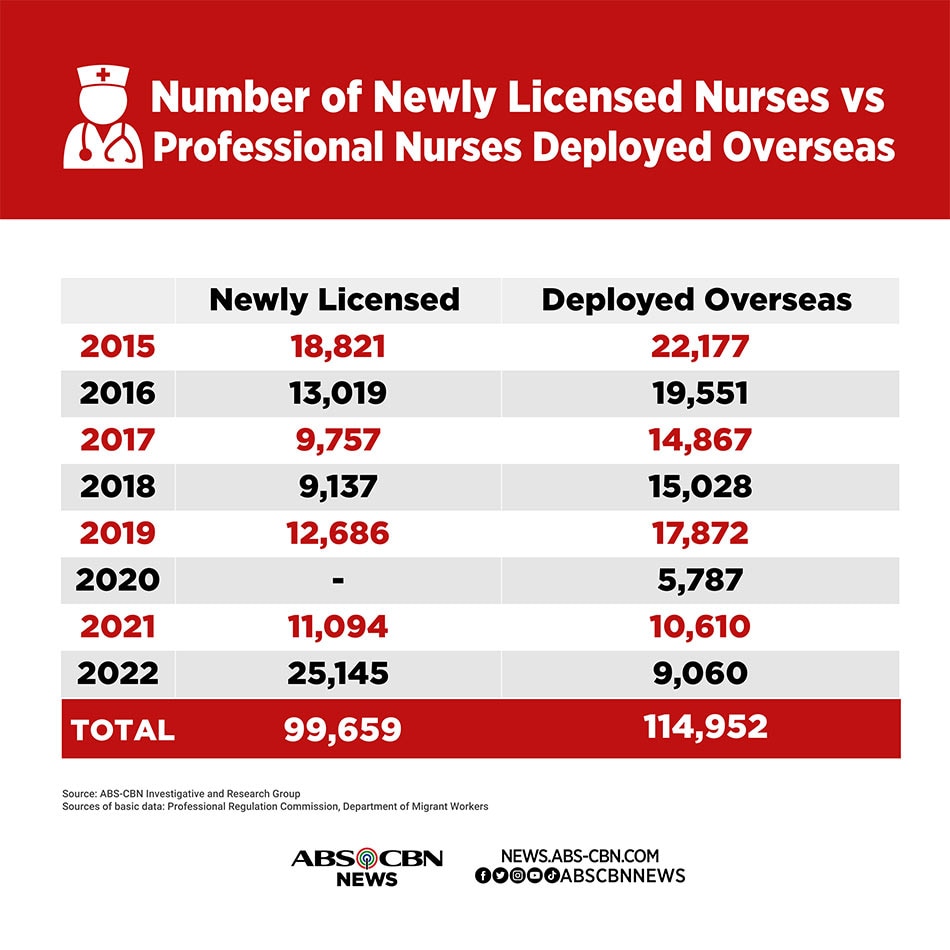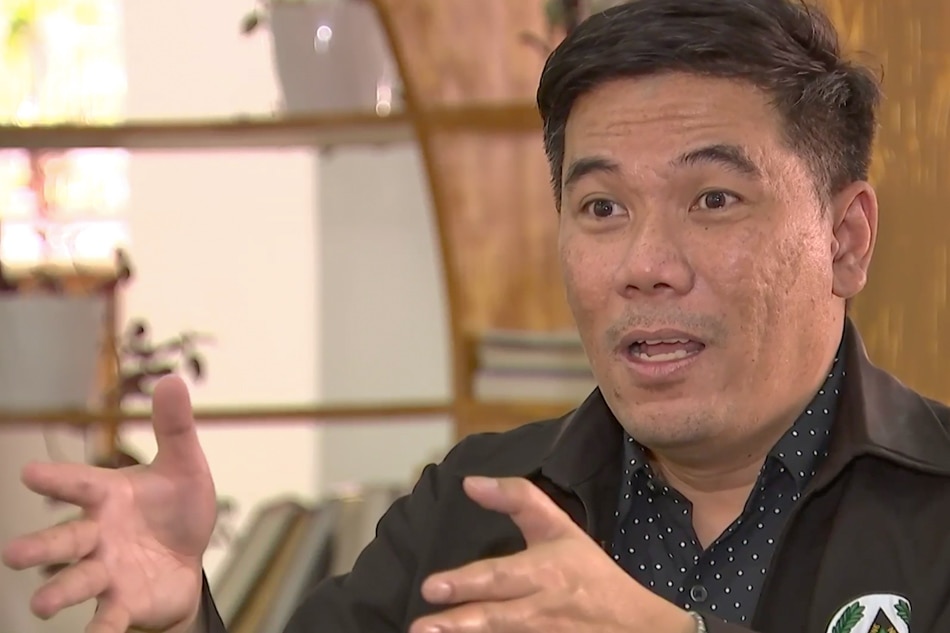Family or country? The hard choice Filipino nurses must make
ADVERTISEMENT

Welcome, Kapamilya! We use cookies to improve your browsing experience. Continuing to use this site means you agree to our use of cookies. Tell me more!
Family or country? The hard choice Filipino nurses must make
Zen Hernandez,
ABS-CBN News
Published Mar 08, 2023 05:46 PM PHT
|
Updated Mar 08, 2023 06:39 PM PHT
MANILA - Amir Pagadilan, a Filipino nurse, wipes his brow after enduring an hour-long interview recently with potential Canadian employers.
MANILA - Amir Pagadilan, a Filipino nurse, wipes his brow after enduring an hour-long interview recently with potential Canadian employers.
Pagadilan, 35, works as a medical encoder in the morning and a hemodialysis nurse at night here in the Philippines, but is hoping to land a job in the Canadian province of Manitoba.
Pagadilan, 35, works as a medical encoder in the morning and a hemodialysis nurse at night here in the Philippines, but is hoping to land a job in the Canadian province of Manitoba.
He admits he has been attempting to leave the country since 2016. But all his efforts were not as fruitful as he had hoped for, until last month.
He admits he has been attempting to leave the country since 2016. But all his efforts were not as fruitful as he had hoped for, until last month.
“Sabi nga lagi ng mom ko, in God’s time," Pagadilan told ABS-CBN News on the sidelines of his application process during the Philippine visit of the delegation from Manitoba last Feb. 21-25.
“Sabi nga lagi ng mom ko, in God’s time," Pagadilan told ABS-CBN News on the sidelines of his application process during the Philippine visit of the delegation from Manitoba last Feb. 21-25.
ADVERTISEMENT
He was choking back tears during the interview, saying, "Masaya lang kasi parang bigay ng Panginoon.”
He was choking back tears during the interview, saying, "Masaya lang kasi parang bigay ng Panginoon.”
(My mom would always say, in God’s time... I’m just happy, it’s an answered prayer.)
(My mom would always say, in God’s time... I’m just happy, it’s an answered prayer.)
Pagadilan passed the interview. Not only that, he was told that he was the only applicant to get a 100 percent rating.
Pagadilan passed the interview. Not only that, he was told that he was the only applicant to get a 100 percent rating.
Pagadilan has his nine years of hard work to thank for. He says it has been a test of resilience. He draws joy and fulfillment from serving Filipino patients.
Pagadilan has his nine years of hard work to thank for. He says it has been a test of resilience. He draws joy and fulfillment from serving Filipino patients.
His job though entails too many sacrifices.
His job though entails too many sacrifices.
ADVERTISEMENT
With a measly income of P150 a day (less than US$3), he had to pay for training and volunteer to get hospital experience, even as he supports a growing family and his mother who is recovering from cancer. His pay improved only when he became a specialist in hemodialysis. Now, he is getting more than P20,000 a month (around US$400).
With a measly income of P150 a day (less than US$3), he had to pay for training and volunteer to get hospital experience, even as he supports a growing family and his mother who is recovering from cancer. His pay improved only when he became a specialist in hemodialysis. Now, he is getting more than P20,000 a month (around US$400).
But with his three kids going to school now, his current income is not enough -- which explains why he has to juggle two jobs and work 16 hours daily.
But with his three kids going to school now, his current income is not enough -- which explains why he has to juggle two jobs and work 16 hours daily.
“You need to look for your worth po eh. Kung saan ka yung mas giginhawa, yung sarili mo and yung family mo, dun ka magpupunta,” Pagadilan said of his decision to leave the country.
“You need to look for your worth po eh. Kung saan ka yung mas giginhawa, yung sarili mo and yung family mo, dun ka magpupunta,” Pagadilan said of his decision to leave the country.
(Where your life can get better, yourself and family, that’s where you must go).
(Where your life can get better, yourself and family, that’s where you must go).
GLOBAL SHORTAGE AND THE SCRAMBLE FOR FILIPINO NURSES
It is becoming almost impossible for Filipino nurses to resist the strong pull of international migration, as high-income countries resort to more aggressive recruitment strategies in the face of a massive global shortage.
It is becoming almost impossible for Filipino nurses to resist the strong pull of international migration, as high-income countries resort to more aggressive recruitment strategies in the face of a massive global shortage.
ADVERTISEMENT
According to the World Health Organization’s (WHO) State of the World’s Nursing report in 2020, the number of nurses needs to increase by eight percent annually to offset a projected shortfall of almost six million by 2030.
According to the World Health Organization’s (WHO) State of the World’s Nursing report in 2020, the number of nurses needs to increase by eight percent annually to offset a projected shortfall of almost six million by 2030.
As a quick fix to nursing workforce deficiencies, rich nations have been scrambling and competing with each other to lure nurses from developing countries. They now offer highly attractive employment and settlement packages, and expedite immigration and accreditation processes.
As a quick fix to nursing workforce deficiencies, rich nations have been scrambling and competing with each other to lure nurses from developing countries. They now offer highly attractive employment and settlement packages, and expedite immigration and accreditation processes.
Several countries have been capitalizing on decades-old deals with the Philippine government to ensure a steady supply of Filipino nurses.
Several countries have been capitalizing on decades-old deals with the Philippine government to ensure a steady supply of Filipino nurses.
Of the more than 25,000 Filipino nursing professionals deployed abroad in the last three years, 34 percent went to Saudi Arabia, 33 percent to the United Kingdom, and 14 percent to Germany.
Of the more than 25,000 Filipino nursing professionals deployed abroad in the last three years, 34 percent went to Saudi Arabia, 33 percent to the United Kingdom, and 14 percent to Germany.
But more and more countries are stepping up their game.
But more and more countries are stepping up their game.
ADVERTISEMENT
Several of Canada’s provincial governments have been reaching out to the Philippine government to express their desire to hire as many Filipino nurses as possible.
Several of Canada’s provincial governments have been reaching out to the Philippine government to express their desire to hire as many Filipino nurses as possible.
In March 2022, the provincial government of Yukon sealed a memorandum of labor cooperation with the Philippine Department of Labor and Employment (DOLE) for the deployment of skilled and professional workers, including nurses. That agreement was ratified by then President Rodrigo Duterte.
In March 2022, the provincial government of Yukon sealed a memorandum of labor cooperation with the Philippine Department of Labor and Employment (DOLE) for the deployment of skilled and professional workers, including nurses. That agreement was ratified by then President Rodrigo Duterte.
By December of the same year, a delegation from Saskatchewan visited the Philippines for a recruitment mission. The Canadian province has an estimated shortage of 2,000 nurses, according to its local health minister.
By December of the same year, a delegation from Saskatchewan visited the Philippines for a recruitment mission. The Canadian province has an estimated shortage of 2,000 nurses, according to its local health minister.
That visit was then followed by delegations from New Brunswick and Manitoba in just a matter of two months.
That visit was then followed by delegations from New Brunswick and Manitoba in just a matter of two months.
MANITOBA MISSION
Manitoba’s delegation was led by its labor and immigration minister, Jon Reyes, who, incidentally, is the son of a Filipino immigrant. According to Reyes, he is proof of Manitoba’s long history with Filipino migrants.
Manitoba’s delegation was led by its labor and immigration minister, Jon Reyes, who, incidentally, is the son of a Filipino immigrant. According to Reyes, he is proof of Manitoba’s long history with Filipino migrants.
ADVERTISEMENT
“This trip was full circle for me. My dad immigrated to Manitoba (in) 1968… To represent our province gave me such great pride and joy to see many of our 'kababayans,' compatriots which we say in the Filipino language, travel from 8 hours away or 5 hours away, after a night shift, coming for this interview,” Reyes said during a press conference immediately after his return from the Philippine mission.
“This trip was full circle for me. My dad immigrated to Manitoba (in) 1968… To represent our province gave me such great pride and joy to see many of our 'kababayans,' compatriots which we say in the Filipino language, travel from 8 hours away or 5 hours away, after a night shift, coming for this interview,” Reyes said during a press conference immediately after his return from the Philippine mission.
Manitoba’s 5-day recruitment in Manila, Iloilo and Cebu City from Feb. 21 to 25 yielded nearly 350 letters of intent offers to trained Filipino healthcare workers, of whom nearly 190 are registered nurses.
Manitoba’s 5-day recruitment in Manila, Iloilo and Cebu City from Feb. 21 to 25 yielded nearly 350 letters of intent offers to trained Filipino healthcare workers, of whom nearly 190 are registered nurses.
"Philippine healthcare professionals want to come to Manitoba. Our government committed to providing a welcoming, streamlined and reasonable process to ensure that internationally educated healthcare providers are able to practice their passion and excel in our healthcare system,” said Manitoban Health Minister Audrey Gordon, as she welcomed Reyes and members of the Manitoban delegation.
"Philippine healthcare professionals want to come to Manitoba. Our government committed to providing a welcoming, streamlined and reasonable process to ensure that internationally educated healthcare providers are able to practice their passion and excel in our healthcare system,” said Manitoban Health Minister Audrey Gordon, as she welcomed Reyes and members of the Manitoban delegation.
Manitoba offers at least 32 Canadian dollars an hour (almost P1,300) or over 5,000 Canadian dollars a month for registered nurses, according to the Canadian government’s Job Bank website. The monthly pay is equivalent to P200,000, or 10 times more than Pagadilan’s current income.
Manitoba offers at least 32 Canadian dollars an hour (almost P1,300) or over 5,000 Canadian dollars a month for registered nurses, according to the Canadian government’s Job Bank website. The monthly pay is equivalent to P200,000, or 10 times more than Pagadilan’s current income.
A three-month settlement package is also included.
A three-month settlement package is also included.
ADVERTISEMENT
Successful applicants will be placed under the provincial nominee program, which means they will become permanent residents and may avail of a family reunification program to bring their loved ones along.
Successful applicants will be placed under the provincial nominee program, which means they will become permanent residents and may avail of a family reunification program to bring their loved ones along.
Manitoba is cutting accreditation period by 12 weeks, after taking cognizance of how the tedious process has been turning away previously recruited Internationally Educated Nurses (IENs).
Manitoba is cutting accreditation period by 12 weeks, after taking cognizance of how the tedious process has been turning away previously recruited Internationally Educated Nurses (IENs).
“I tried my best to be licensed there, but it's not really working out. Like, first step, negative; second step, negative. So yeah, it was a 2 to 3 years process and I cannot see the end of the tunnel… Right now I am in Tennessee,” said Nikka Reyes, a Filipino nurse who initially went to Manitoba’s capital city, Winnipeg, in 2015 but left for the United States in 2020.
“I tried my best to be licensed there, but it's not really working out. Like, first step, negative; second step, negative. So yeah, it was a 2 to 3 years process and I cannot see the end of the tunnel… Right now I am in Tennessee,” said Nikka Reyes, a Filipino nurse who initially went to Manitoba’s capital city, Winnipeg, in 2015 but left for the United States in 2020.
Manitoba assured it is committed to helping IENs succeed, as they are one of 30 initiatives in the province’s health human resource action plan. The province is hoping to fill 1,500 to 2,000 nursing vacancies, mostly in rural areas.
Manitoba assured it is committed to helping IENs succeed, as they are one of 30 initiatives in the province’s health human resource action plan. The province is hoping to fill 1,500 to 2,000 nursing vacancies, mostly in rural areas.
THE PHILIPPINES AND ITS OWN BLEEDING HEALTHCARE SYSTEM
It goes without saying that highly-skilled nurses are greatly sought-after. They can be utilized to supervise health services, provide specialist advice and train younger nurses.
It goes without saying that highly-skilled nurses are greatly sought-after. They can be utilized to supervise health services, provide specialist advice and train younger nurses.
ADVERTISEMENT
Pagadilan himself is a mentor and a clinical instructor. It will not be easy to find a replacement once his immigration to Canada pushes through.
Pagadilan himself is a mentor and a clinical instructor. It will not be easy to find a replacement once his immigration to Canada pushes through.
“Ang ganda ng training nila. So centers abroad gustong-gusto nilang kunin. Eh we don’t have enough of those nurses right now. Konti lang talaga. So pagka kinuha nila yan, napakalaking problema. We have to retrain again, and then hindi ganon kadali,” Dr. Rene de Grano, President of the Private Hospitals Association of the Philippines (PHAP), lamented.
“Ang ganda ng training nila. So centers abroad gustong-gusto nilang kunin. Eh we don’t have enough of those nurses right now. Konti lang talaga. So pagka kinuha nila yan, napakalaking problema. We have to retrain again, and then hindi ganon kadali,” Dr. Rene de Grano, President of the Private Hospitals Association of the Philippines (PHAP), lamented.
(They have good training, so centers abroad are eager to recruit them. We don’t have enough of those nurses. There’s just a few of them. Losing them will be a big problem. We have to retrain again and it’s not going to be easy.)
(They have good training, so centers abroad are eager to recruit them. We don’t have enough of those nurses. There’s just a few of them. Losing them will be a big problem. We have to retrain again and it’s not going to be easy.)
The PHAP said private hospitals went into the COVID-19 pandemic with a massive 40 percent shortage in its nursing workforce. And yet, the outflow of nurses continued even during the height of the global health emergency.
The PHAP said private hospitals went into the COVID-19 pandemic with a massive 40 percent shortage in its nursing workforce. And yet, the outflow of nurses continued even during the height of the global health emergency.
Data gathered by the ABS-CBN Investigative and Research Group show that almost 6,000 Filipino nursing professionals have left despite a government-imposed deployment cap of 5,000 in 2020. It must be noted that the Philippines was not able to produce licensed nurses that year, after the cancellation of the board exam due to COVID-19 restrictions and community lockdowns.
Data gathered by the ABS-CBN Investigative and Research Group show that almost 6,000 Filipino nursing professionals have left despite a government-imposed deployment cap of 5,000 in 2020. It must be noted that the Philippines was not able to produce licensed nurses that year, after the cancellation of the board exam due to COVID-19 restrictions and community lockdowns.
ADVERTISEMENT
In 2021, the deployment cap was raised to 7,000 and yet the deployment was over 10,000, followed by another 9,000 in 2022.
In 2021, the deployment cap was raised to 7,000 and yet the deployment was over 10,000, followed by another 9,000 in 2022.
A closer scrutiny of the total deployment figure from 2015 to 2022 shows that the outflow of nurses is greater than the country’s production of licensed nurses.
A closer scrutiny of the total deployment figure from 2015 to 2022 shows that the outflow of nurses is greater than the country’s production of licensed nurses.
Notes: Data on newly licensed nurses was culled from the results of the Philippine Nurse Licensure Exam (NLE) uploaded by the PRC on its website. The NLE was postponed in 2020 due to the pandemic. Data on deployed nurses overseas includes the skill title “nursing professionals” and “supervisors nursing” and excludes “nursing associate professionals.” Data on deployed nurses overseas from 2018 to 2022 is preliminary.
This is a huge burden on those who are left behind, who are already spreading themselves too thinly even before the pandemic and even more during its onslaught.
This is a huge burden on those who are left behind, who are already spreading themselves too thinly even before the pandemic and even more during its onslaught.
Based on the Department of Health’s (DOH) own monitoring, trainees and even support staff like nursing aides are now being tapped to man wards due to the worsening manpower shortage.
Based on the Department of Health’s (DOH) own monitoring, trainees and even support staff like nursing aides are now being tapped to man wards due to the worsening manpower shortage.
“Pag alam nating training lang, posible na tama or mali. Sa madaling salita meron kang pag-alala talaga,” Rhea Patulay, a patient’s wife, said of trainees.
“Pag alam nating training lang, posible na tama or mali. Sa madaling salita meron kang pag-alala talaga,” Rhea Patulay, a patient’s wife, said of trainees.
ADVERTISEMENT
But even such a workaround is not enough. Many hospitals are still struggling to admit patients or worse, are forced to close some wards.
But even such a workaround is not enough. Many hospitals are still struggling to admit patients or worse, are forced to close some wards.
“Marami kaming beds but then who will manage? Kung kulang kami ng nurses, limited ang paga-admit namin… Pag talagang pagod na sila, bigla na lang mag-a-absent yan. Sasabihin ‘pagod na po kami eh, I’m sick already,’” PHAP’s De Grano said.
“Marami kaming beds but then who will manage? Kung kulang kami ng nurses, limited ang paga-admit namin… Pag talagang pagod na sila, bigla na lang mag-a-absent yan. Sasabihin ‘pagod na po kami eh, I’m sick already,’” PHAP’s De Grano said.
(We have a lot of beds. But if we lack nurses, our admission is limited. When they get really tired, they will miss work. They will just say, 'we’re tired.')
(We have a lot of beds. But if we lack nurses, our admission is limited. When they get really tired, they will miss work. They will just say, 'we’re tired.')
Last year, DOH officer-in-charge (OIC) Maria Rosario Vergeire announced the country’s need for 106,000 additional nurses. Today, the figure has swelled drastically.
Last year, DOH officer-in-charge (OIC) Maria Rosario Vergeire announced the country’s need for 106,000 additional nurses. Today, the figure has swelled drastically.
“During the time of the pandemic, certain hospitals, the small hospitals, private ones, have closed because they lack the manpower already… 350,000 plus ang kailangan natin para malagyan natin lahat ng pangangailangan natin dito sa healthcare sector,” she said.
“During the time of the pandemic, certain hospitals, the small hospitals, private ones, have closed because they lack the manpower already… 350,000 plus ang kailangan natin para malagyan natin lahat ng pangangailangan natin dito sa healthcare sector,” she said.
ADVERTISEMENT
(We need 350,000 plus to fill the demands of our own healthcare sector.)
(We need 350,000 plus to fill the demands of our own healthcare sector.)
The need is based on recommended nurse-to-patient ratios that guarantee the delivery of quality care and patient safety.
The need is based on recommended nurse-to-patient ratios that guarantee the delivery of quality care and patient safety.
“Emergency room, it’s usually 1:4, (or) 1 nurse is to 4 patients. If you are in the ICU, it’s usually 1:1 or 1:2. Kapag naman nasa OR, ganon din, may mga ratio iba-iba. So ngayon, ang napapansin natin, our hospitals are really crying. Kasi, sinasabi nila na dun sa emergency room, minsan nagiging 1:10 na sila, minsan 1:12 na sila, dahil nga sa dami ng pasyente, kakaunti ang nurses natin. Kapag sa ICU, instead of being one on one with the patient, sometimes you get 4 patients,” Vergeire said of the situation in both public and private hospitals.
“Emergency room, it’s usually 1:4, (or) 1 nurse is to 4 patients. If you are in the ICU, it’s usually 1:1 or 1:2. Kapag naman nasa OR, ganon din, may mga ratio iba-iba. So ngayon, ang napapansin natin, our hospitals are really crying. Kasi, sinasabi nila na dun sa emergency room, minsan nagiging 1:10 na sila, minsan 1:12 na sila, dahil nga sa dami ng pasyente, kakaunti ang nurses natin. Kapag sa ICU, instead of being one on one with the patient, sometimes you get 4 patients,” Vergeire said of the situation in both public and private hospitals.
(In the OR, there is also a different ratio. What we have observed is that our hospitals are really crying. They are saying that in emergency rooms, the ratio has become 1:10 and even 1:12 sometimes, due to the volume of patients and the limited number of our nurses.)
(In the OR, there is also a different ratio. What we have observed is that our hospitals are really crying. They are saying that in emergency rooms, the ratio has become 1:10 and even 1:12 sometimes, due to the volume of patients and the limited number of our nurses.)
Vergeire admits there are a number of factors affecting the supply of nurses in Philippine hospitals.
Vergeire admits there are a number of factors affecting the supply of nurses in Philippine hospitals.
ADVERTISEMENT
Nursing schools experience high attrition rates due to students’ financial woes. Passing rate for the Nursing Licensure Exam (NLE) is woefully low at 60 percent. Meanwhile, a good 40 percent of fully licensed nurses refuse to work in hospitals, switching careers in better paying sectors, like Business Process Outsourcing (BPO).
Nursing schools experience high attrition rates due to students’ financial woes. Passing rate for the Nursing Licensure Exam (NLE) is woefully low at 60 percent. Meanwhile, a good 40 percent of fully licensed nurses refuse to work in hospitals, switching careers in better paying sectors, like Business Process Outsourcing (BPO).
And a significant 30 percent are lured to work in other countries annually, causing the DOH to grow increasingly frustrated and uneasy.
And a significant 30 percent are lured to work in other countries annually, causing the DOH to grow increasingly frustrated and uneasy.
Certainly, offers from high-income nations are impossible to match.
Certainly, offers from high-income nations are impossible to match.
“Hindi natin pwedeng pwersahin ang ating nurses to stay and work with us. Because that is their right - they have the right to pursue their career, have this greener pasture. Pero it’s quite alarming because kapag ganito na yung nangyayaring kalakaran and this is happening already, we are seeing that we will lose more of these nurses in the coming weeks, coming months or coming years," Vergeire said.
“Hindi natin pwedeng pwersahin ang ating nurses to stay and work with us. Because that is their right - they have the right to pursue their career, have this greener pasture. Pero it’s quite alarming because kapag ganito na yung nangyayaring kalakaran and this is happening already, we are seeing that we will lose more of these nurses in the coming weeks, coming months or coming years," Vergeire said.
"And that would really drain our country."
"And that would really drain our country."
ADVERTISEMENT
(We cannot force our nurses to stay. But it is quite alarming, if this is now the state of affairs.)
(We cannot force our nurses to stay. But it is quite alarming, if this is now the state of affairs.)
QUESTIONS ON ETHICAL RECRUITMENT
The WHO had previously warned that unmanaged migration can worsen the inequitable distribution of nurses and more importantly, access to health services in countries with already fragile health systems.
The WHO had previously warned that unmanaged migration can worsen the inequitable distribution of nurses and more importantly, access to health services in countries with already fragile health systems.
Based on the WHO’s study, one nurse out of every 8 is now practicing in a country outside of where they were born or trained.
Based on the WHO’s study, one nurse out of every 8 is now practicing in a country outside of where they were born or trained.
The International Council of Nurses (ICN) as well is blatantly criticizing to what it says is the seemingly excessive reliance of high-income nations to overseas recruitment, calling it a “global shopping trip.”
The International Council of Nurses (ICN) as well is blatantly criticizing to what it says is the seemingly excessive reliance of high-income nations to overseas recruitment, calling it a “global shopping trip.”
ICN Chief Executive Officer Howard Catton urges wealthy nations to do more for source countries.
ICN Chief Executive Officer Howard Catton urges wealthy nations to do more for source countries.
ADVERTISEMENT
“New equipment shouldn't be a surprise. You should be talking to governments, to the key health organizations… Perhaps you might want to invest in building a nursing school…. It's very difficult to see that sort of arrangement as anything other than really exploitative of countries and using your high income power to secure a good or a service that you need without paying a fair, proper price for that,” he said.
“New equipment shouldn't be a surprise. You should be talking to governments, to the key health organizations… Perhaps you might want to invest in building a nursing school…. It's very difficult to see that sort of arrangement as anything other than really exploitative of countries and using your high income power to secure a good or a service that you need without paying a fair, proper price for that,” he said.
As for the recent recruitment mission from Manitoba, its government pointed out that it has been operating under a Memorandum of Understanding (MOU) with the Philippines. It has also committed to providing support by offering a scholarship fund for Filipino nursing students who wish to work in Canada.
As for the recent recruitment mission from Manitoba, its government pointed out that it has been operating under a Memorandum of Understanding (MOU) with the Philippines. It has also committed to providing support by offering a scholarship fund for Filipino nursing students who wish to work in Canada.
“The MOU dates back to 2010, it’s been in place for some time now. It’s very much a give-and-take relationship. So we are in talks at the moment with the Philippine government as well as the Canadian government on how we can give back to the Philippines,” Gordon, Manitoba’s Health Minister, said.
“The MOU dates back to 2010, it’s been in place for some time now. It’s very much a give-and-take relationship. So we are in talks at the moment with the Philippine government as well as the Canadian government on how we can give back to the Philippines,” Gordon, Manitoba’s Health Minister, said.
Germany also denied “pirating” Filipino nursing students. In a twitter post last January, its ambassador to the Philippines, Anke Reiffenstuel, said her country "works closely with Philippine schools, colleges and agencies in its recruitment efforts” and “offers good salaries, social services and upskilling for Filipino healthcare workers.”
Germany also denied “pirating” Filipino nursing students. In a twitter post last January, its ambassador to the Philippines, Anke Reiffenstuel, said her country "works closely with Philippine schools, colleges and agencies in its recruitment efforts” and “offers good salaries, social services and upskilling for Filipino healthcare workers.”
Reiffenstuel also said that Germany and the Philippines’ Triple Win Program (the employment program for Filipino nurses inked in March 2013) “is a big success.”
Reiffenstuel also said that Germany and the Philippines’ Triple Win Program (the employment program for Filipino nurses inked in March 2013) “is a big success.”
ADVERTISEMENT
Vergeire, the Philippines' health chief, believes a scholarship in exchange for every deployed Filipino nurse is a reasonable minimum requirement from all countries recruiting in the Philippines.
Vergeire, the Philippines' health chief, believes a scholarship in exchange for every deployed Filipino nurse is a reasonable minimum requirement from all countries recruiting in the Philippines.
She also feels strongly against expedited pathways of recruitment, saying the Philippines must set conditions to develop a more calibrated approach to the hiring and deployment process.
She also feels strongly against expedited pathways of recruitment, saying the Philippines must set conditions to develop a more calibrated approach to the hiring and deployment process.
“Yung two years na kundisyon na ite-train mo sila dito, they still stay with us, bago mo kunin. At least nade-determine natin kung ilan yung paalis, ilan yung magste-stay, ilan yung babalik, para hindi tayo agad nawawalan at hindi natin alam kung paano natin bibigyan ng solusyon,” said Vergeire.
“Yung two years na kundisyon na ite-train mo sila dito, they still stay with us, bago mo kunin. At least nade-determine natin kung ilan yung paalis, ilan yung magste-stay, ilan yung babalik, para hindi tayo agad nawawalan at hindi natin alam kung paano natin bibigyan ng solusyon,” said Vergeire.
(A condition requiring two years of training, before taking them away will let us determine how many are leaving, how many are staying, how many are coming back, so we will not suddenly lose manpower, without knowing how to resolve it.)
(A condition requiring two years of training, before taking them away will let us determine how many are leaving, how many are staying, how many are coming back, so we will not suddenly lose manpower, without knowing how to resolve it.)
THE MORE SUSTAINABLE STRATEGY
For ICN’s Catton, the situation is now both a national security and a safety issue because of the massive threat to healthcare systems and the safety of patients all over the world.
For ICN’s Catton, the situation is now both a national security and a safety issue because of the massive threat to healthcare systems and the safety of patients all over the world.
ADVERTISEMENT
Both ICN and the WHO identify heavily investing in nurses as the only sustainable strategy for every country.
Both ICN and the WHO identify heavily investing in nurses as the only sustainable strategy for every country.
“What we need all countries to do, and particularly high-income countries, is to focus more on being self-sufficient, educating enough nurses to meet their own needs… Provide fair, paid, decent work, to properly value people, nurses in their countries,” Catton said.
“What we need all countries to do, and particularly high-income countries, is to focus more on being self-sufficient, educating enough nurses to meet their own needs… Provide fair, paid, decent work, to properly value people, nurses in their countries,” Catton said.
This has always been the battle cry of the Philippine Nurses Association (PNA).
This has always been the battle cry of the Philippine Nurses Association (PNA).
The group laments how Filipino nurses are being deprived to live with decency and dignity in their own country. While it is true that the COVID-19 pandemic has been a wake-up call for all governments and policy makers, the PNA believes the Philippine government is not doing enough to significantly improve the dismal working conditions of most nurses.
The group laments how Filipino nurses are being deprived to live with decency and dignity in their own country. While it is true that the COVID-19 pandemic has been a wake-up call for all governments and policy makers, the PNA believes the Philippine government is not doing enough to significantly improve the dismal working conditions of most nurses.
To say that there is widespread frustration among Filipino nurses is an understatement. It is at a breaking point and this is what high-income countries are taking advantage of.
To say that there is widespread frustration among Filipino nurses is an understatement. It is at a breaking point and this is what high-income countries are taking advantage of.
ADVERTISEMENT
“I think we really need to see welfare as a core priority agenda for Filipino nurses. These countries will be aggressive, they will continue to be more aggressive because they see na walang ginagawa ang ating gobyerno,” PNA President Melvin Miranda said.
“I think we really need to see welfare as a core priority agenda for Filipino nurses. These countries will be aggressive, they will continue to be more aggressive because they see na walang ginagawa ang ating gobyerno,” PNA President Melvin Miranda said.
(These countries will continue to be aggressive because they see that the government is not doing anything.)
(These countries will continue to be aggressive because they see that the government is not doing anything.)
The PNA is lobbying for the passage of a nursing bill in Congress that aims to resolve the myriad of long standing issues, including: low wages and benefits, security of tenure for nursing positions, the limited funding for health emergency allowances, the absence of a retention plan and an advanced practice program, as well as the need for reforms in both nursing education and the practice of the nursing profession.
The PNA is lobbying for the passage of a nursing bill in Congress that aims to resolve the myriad of long standing issues, including: low wages and benefits, security of tenure for nursing positions, the limited funding for health emergency allowances, the absence of a retention plan and an advanced practice program, as well as the need for reforms in both nursing education and the practice of the nursing profession.
The DOH assured that it has been actively participating in discussions with lawmakers on the standardization of nurses’ wages and benefits.
The DOH assured that it has been actively participating in discussions with lawmakers on the standardization of nurses’ wages and benefits.
Vergeire said she supports the call to fix the immense disparity in wages between public and private hospitals. But she also admits, impact on all stakeholders must be heavily considered.
Vergeire said she supports the call to fix the immense disparity in wages between public and private hospitals. But she also admits, impact on all stakeholders must be heavily considered.
ADVERTISEMENT
In 2020, Duterte signed the Salary Standardization Law which raised the starting salary of nurses in government healthcare facilities to Salary Grade 15 or P32,000 a month (almost US$600). But there is no legal way of forcing private hospitals to follow suit.
In 2020, Duterte signed the Salary Standardization Law which raised the starting salary of nurses in government healthcare facilities to Salary Grade 15 or P32,000 a month (almost US$600). But there is no legal way of forcing private hospitals to follow suit.
According to Department Order 182-17 by the DOLE, or the Guidelines Governing the Employment and Working Conditions of Health Personnel in the Private Healthcare Industry, health personnel are entitled to not less than the applicable minimum wage rate. The highest minimum wage rate in the Philippines is in the National Capital Region (NCR), pegged at P570 a day or just a little over US$10.
According to Department Order 182-17 by the DOLE, or the Guidelines Governing the Employment and Working Conditions of Health Personnel in the Private Healthcare Industry, health personnel are entitled to not less than the applicable minimum wage rate. The highest minimum wage rate in the Philippines is in the National Capital Region (NCR), pegged at P570 a day or just a little over US$10.
The option of mandating a higher salary for nurses in the private sector may cause more harm than good, according to the PHAP.
The option of mandating a higher salary for nurses in the private sector may cause more harm than good, according to the PHAP.
“Maraming magsasara and maapektuhan again ang ating healthcare system. Remember, ang mga private hospitals, 60 percent ng ating hospital facilities are private… We don’t have subsidy from the government katulad ng government facilities. So wala kaming pagkukunan. Otherwise, tataas ang hospitalization cost ng ating mga pasyente,” de Grano said.
“Maraming magsasara and maapektuhan again ang ating healthcare system. Remember, ang mga private hospitals, 60 percent ng ating hospital facilities are private… We don’t have subsidy from the government katulad ng government facilities. So wala kaming pagkukunan. Otherwise, tataas ang hospitalization cost ng ating mga pasyente,” de Grano said.
(Many will shut down and our healthcare system will be affected. Private hospitals make up 60 percent of hospital facilities… We’re not like government facilities, we don’t have other sources of income. Otherwise, hospitalization costs for patients will increase.)
(Many will shut down and our healthcare system will be affected. Private hospitals make up 60 percent of hospital facilities… We’re not like government facilities, we don’t have other sources of income. Otherwise, hospitalization costs for patients will increase.)
ADVERTISEMENT
Nurses working in public hospitals are not necessarily happier as well. The PNA has been receiving numerous complaints about delayed payment of benefits and the lack of security in tenure.
Nurses working in public hospitals are not necessarily happier as well. The PNA has been receiving numerous complaints about delayed payment of benefits and the lack of security in tenure.
“Still contract of service, still on the job orders. So nagfa-factor in dun sa ganung problema eh, madami. 2 years, 3 years still a job order, still a problem,” PNA’s Miranda said.
“Still contract of service, still on the job orders. So nagfa-factor in dun sa ganung problema eh, madami. 2 years, 3 years still a job order, still a problem,” PNA’s Miranda said.
(This is yet another factor in the problem, there’s many.)
(This is yet another factor in the problem, there’s many.)
The Philippines continues to lag behind South Asian neighbors when it comes to compensating nurses. A study by information aggregator iPrice group showed that Filipino nurses earned the least in the region.
The Philippines continues to lag behind South Asian neighbors when it comes to compensating nurses. A study by information aggregator iPrice group showed that Filipino nurses earned the least in the region.
The salary of Filipino registered nurses is 57 percent less than the next lowest paid nurses in Vietnam, who get an equivalent to over P62,000 per month (more than US$1,100). On the other hand, Singaporean nurses earn a whopping P274,000 per month, the highest in the region and 486 percent more than in the Philippines.
The salary of Filipino registered nurses is 57 percent less than the next lowest paid nurses in Vietnam, who get an equivalent to over P62,000 per month (more than US$1,100). On the other hand, Singaporean nurses earn a whopping P274,000 per month, the highest in the region and 486 percent more than in the Philippines.
ADVERTISEMENT
As the discussion on nurses’ wages and benefits heat up, the DOH is looking into other short-term and long-term measures.
As the discussion on nurses’ wages and benefits heat up, the DOH is looking into other short-term and long-term measures.
It is studying an educational program that would allow allied healthcare professionals to train, practice and later on pursue further studies that would help them become nurses or doctors. Development partners are also being tapped to provide more training opportunities and scholarships.
It is studying an educational program that would allow allied healthcare professionals to train, practice and later on pursue further studies that would help them become nurses or doctors. Development partners are also being tapped to provide more training opportunities and scholarships.
The DOH is also studying how unlicensed nurses can be trained, utilized and supported to pass the licensure exam.
The DOH is also studying how unlicensed nurses can be trained, utilized and supported to pass the licensure exam.
“Dapat ASAP, lahat-lahat because we’d like to stop the bleeding as soon as we can,” Vergeire said.
“Dapat ASAP, lahat-lahat because we’d like to stop the bleeding as soon as we can,” Vergeire said.
(It should be ASAP, all of it.)
(It should be ASAP, all of it.)
ADVERTISEMENT
But for nurses like Pagadilan, leaving the country for a nursing job abroad has more advantages than when staying and waiting for the planned measures to materialize. Although it is a painful decision for him, he said he has responsibilities to fulfill as a father, a husband and a son.
But for nurses like Pagadilan, leaving the country for a nursing job abroad has more advantages than when staying and waiting for the planned measures to materialize. Although it is a painful decision for him, he said he has responsibilities to fulfill as a father, a husband and a son.
“Sana yung serbisyo sa bayan, maserbisyuhan din yung nagseserbisyo sa bayan. Parang i-return naman sana yung favor din sa mga tao na hardworking at tinatawag nilang bayani lalo na ng pandemya,” he said.
“Sana yung serbisyo sa bayan, maserbisyuhan din yung nagseserbisyo sa bayan. Parang i-return naman sana yung favor din sa mga tao na hardworking at tinatawag nilang bayani lalo na ng pandemya,” he said.
(I wish the country could also serve those who are serving it, like returning the favor to all these hardworking people we call heroes, especially during the pandemic.)
(I wish the country could also serve those who are serving it, like returning the favor to all these hardworking people we call heroes, especially during the pandemic.)
Pagadilan is hoping that Filipino nurses will not have to wait long until finally getting the fair treatment they deserve in their home country.
Pagadilan is hoping that Filipino nurses will not have to wait long until finally getting the fair treatment they deserve in their home country.
In his case though, a decision has been made in favor of his family and there is no turning back.
In his case though, a decision has been made in favor of his family and there is no turning back.
Read More:
Filipino nurses
World Health Organization
WHO
migration
Department of Health
DOH
Philippine Nurses Association
International Council of Nurses
nurse
Amir Pagadilan
ADVERTISEMENT
ADVERTISEMENT



